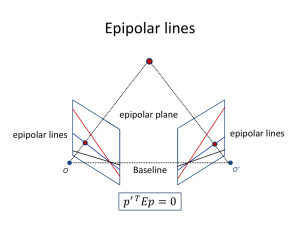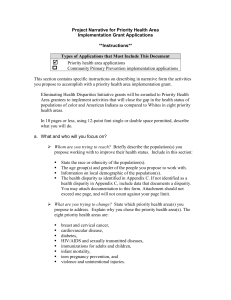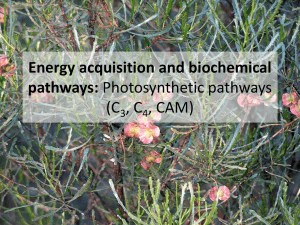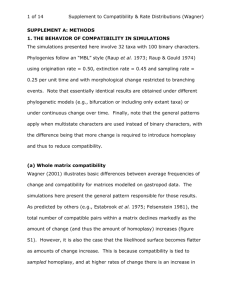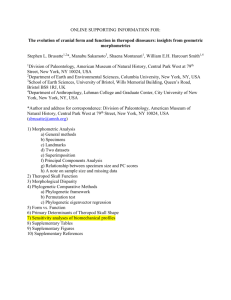assignment as Word file
advertisement
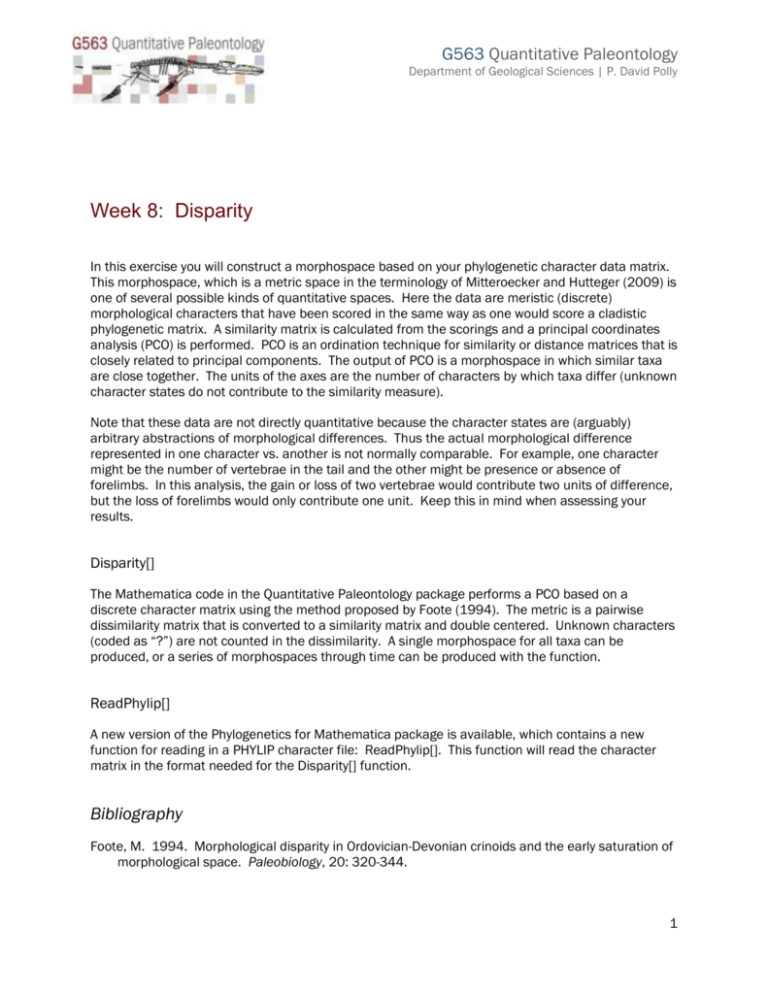
G563 Quantitative Paleontology Department of Geological Sciences | P. David Polly Week 8: Disparity In this exercise you will construct a morphospace based on your phylogenetic character data matrix. This morphospace, which is a metric space in the terminology of Mitteroecker and Hutteger (2009) is one of several possible kinds of quantitative spaces. Here the data are meristic (discrete) morphological characters that have been scored in the same way as one would score a cladistic phylogenetic matrix. A similarity matrix is calculated from the scorings and a principal coordinates analysis (PCO) is performed. PCO is an ordination technique for similarity or distance matrices that is closely related to principal components. The output of PCO is a morphospace in which similar taxa are close together. The units of the axes are the number of characters by which taxa differ (unknown character states do not contribute to the similarity measure). Note that these data are not directly quantitative because the character states are (arguably) arbitrary abstractions of morphological differences. Thus the actual morphological difference represented in one character vs. another is not normally comparable. For example, one character might be the number of vertebrae in the tail and the other might be presence or absence of forelimbs. In this analysis, the gain or loss of two vertebrae would contribute two units of difference, but the loss of forelimbs would only contribute one unit. Keep this in mind when assessing your results. Disparity[] The Mathematica code in the Quantitative Paleontology package performs a PCO based on a discrete character matrix using the method proposed by Foote (1994). The metric is a pairwise dissimilarity matrix that is converted to a similarity matrix and double centered. Unknown characters (coded as “?”) are not counted in the dissimilarity. A single morphospace for all taxa can be produced, or a series of morphospaces through time can be produced with the function. ReadPhylip[] A new version of the Phylogenetics for Mathematica package is available, which contains a new function for reading in a PHYLIP character file: ReadPhylip[]. This function will read the character matrix in the format needed for the Disparity[] function. Bibliography Foote, M. 1994. Morphological disparity in Ordovician-Devonian crinoids and the early saturation of morphological space. Paleobiology, 20: 320-344. 1 Mitteroecker, P. and S. M. Hutteger. 2009. The concept of morphospaces in evolutionary and developmental biology: mathematics and metaphors. Biological Theory, 41: 54-67. Assignment 1. Familiarize yourself with the Disparity function in the Quantitative Paleontology package. 2. Create a morphospace with the Disparity[] function for the discrete character data set you used for phylogenetic analysis. 3. Evaluate the apparent disparity in your group: a. Which taxa are the most disparate? In which characters do they differ? b. Which taxa are the least disparate? In which characters do they differ? c. Based on the animals (or plants) as wholes, do you think the disparity and character differences are reasonable representations of their real differences? d. Based on the spacing of taxa in the morphospace plot, can you ascribe a biological or ecological meaning to the ordering of taxa? (e.g., is one end of the plot filled by long limbed carnivores and the other end filled by short limbed herbivores?) 4. Can you estimate disparity for taxa with continuous traits? a. How might you calculate a disparity index for continuous traits? b. Can you calculate disparity for the Marmot data from last assignment? c. What would be the expected disparity for taxa with two traits, each evolving with a step rate of 1.0 for 100 steps? (explain your work) Reading Lloyd, G. T., K. E. Davis, D. Pisani, J. E. Tarver, M. Ruta, M. Sakamoto, D. W. E. Hone, R. Jennings, and M. J. Benton. 2008. Dinosaurs and the Cretaceous terrestrial revolution. Proceedings of the Royal Society B, 275: 2483-2490. Sepkoski, J. J., Jr. 1993. Ten years in the library: new data confirm paleontological patterns. Paleobiology, 19: 43-51. 2






